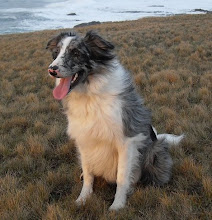
A gradiometer is an instrument that senses, or rather records tiny changes in the earth's magnetic field. As such they are able to "see" ditches, pits, walls, hearths, and furness'. Well sometimes - they are a quick efficient means of archaeologically surveying an area (and that means cheap! always a bonus!) however " an absence of results does not mean an absence of archaeology". Sometimes the archaeology just isn't magnetically different enough, or can be 'masked' by modern detritus/development. Iron overloads the instrument and you wouldn't believe how much iron based rubbish is scattered around, even in rural situations. Until recently Sue and I were using a bartington, see below surveying on Iona. They require a harness over your shoulders to hang the instrument in front of you.

The one we preferred was the original, a hard alloy frame looking like roman armour over your shoulders -otherwise referred to as the "Xena" harness (detail below).

Their are several others, popular amongst our colleagues is a home made soft harness. It's like a sideways figure 8 that clips to the instrument and is called the "Soft" Harness. Although it acts more like a cross your heart wonder bra, but that name would be politically incorrect, too long and probably not popular with female staff (which is why you're not getting a close up photo of that one!)
There is now a new one supplied by Bartington that is like a day sack. The instrument attaches at the front and a water pouch on the back acts as a counter balance, but at something like £600 just for the harness I doubt many are up grading!





